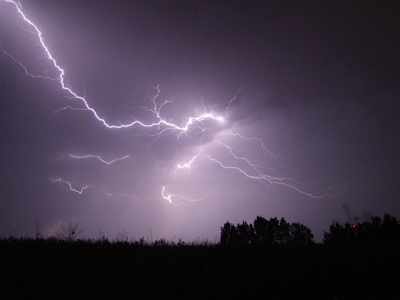
Facts About Thunderstorms
Thunderstorms may be a beautiful force of nature, but they are also capable of causing a lot of damage. In addition to dangerous lightning, thunderstorms can produce intense winds, softball-sized hail, and even tornadoes, according to the National Weather Service. They can cause extensive property damage and personal injury, especially if the proper precautions aren't taken. At ServiceMaster Restore®, our goal is to help minimize these hazards by correcting some myths about thunderstorms and lightning.
MYTH: You Can Take Shelter Under A Tree During A Thunderstorm.
FACT: This is one of the most dangerous myths about thunderstorms, resulting in numerous casualties every year. When a tree is struck by lightning, the current can make its way down the trunk and into the ground, creating a dangerous "ground charge" around the tree. What’s more, tree limbs damaged by a lightning strike can easily fall and cause injury. Always seek shelter indoors or in a fully enclosed vehicle instead.
MYTH: If You're Not Directly Under The Clouds, You’re Safe From Lightning Strikes.
FACT: Many people feel they are a safe distance from a thunderstorm as long as they are not directly under the storm clouds. The problem is that it’s not uncommon for lightning to strike up to three miles or more away from the center of the storm. If a thunderstorm is in the area, then it's best to stay indoors. Stay ahead of the danger by keeping an eye out for thunderstorm watches and warnings and know the difference between the two.
MYTH: Lightning Only Strikes Tall Objects.
FACT: One of the most common lightning myths is that lightning only strikes objects that are high up off the ground. It is true that tall objects are slightly more susceptible to lightning strikes because they reduce the distance that the lightning needs to travel from the clouds. However, lightning can and often does strike the ground or objects close to the ground as well. You won't be safe from a lightning strike just because there is a taller object such as a tree or telephone pole nearby.
MYTH: Storm Shutters Are Only For Hurricanes And Tornadoes.
FACT: Windows are highly vulnerable to damage from hail and flying debris produced during a severe thunderstorm. You can protect your windows during thunderstorm season by installing a quality pair of storm shutters. If your windows do not have storm shutters, then you can still reduce damage to the inside of your home by closing all blinds, shades, curtains, and drapes.
MYTH: Metal Objects Attract Lightning.
FACT: Perhaps the most persistent of all myths about thunderstorms is that metal objects attract lightning. The presence of metal does not make a difference as to where lightning strikes. If there is a risk, it’s in metal’s ability to conduct electricity once it is struck. For this reason, you should stay away from long metal objects, such as fences, during a thunderstorm.
Your home is the best place to take shelter during a thunderstorm, but high winds, hail, and heavy rain can still cause issues such as broken windows, loose shingles, and interior flooding. You can trust the experts at ServiceMaster Restore to quickly access the impact of any damage and to get your home back to its pre-loss condition. Call us today at 1-800-RESPOND.
